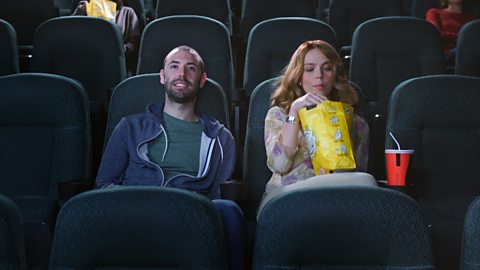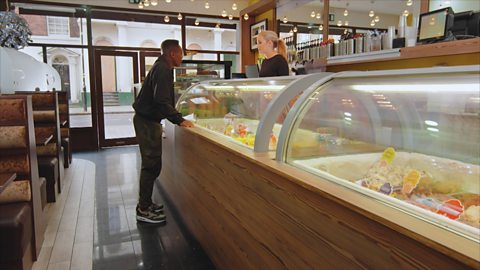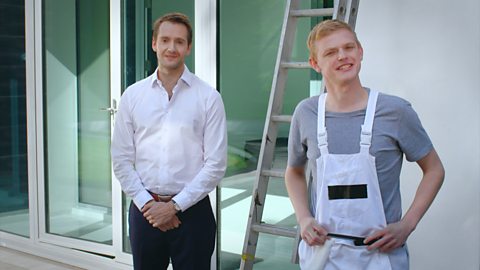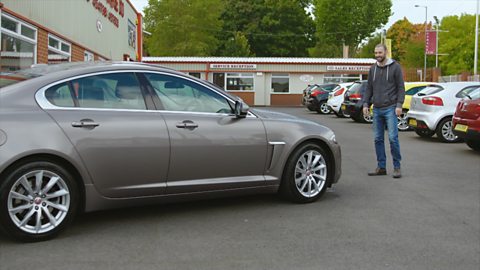CLIMBER:So I'm here at base camp.
CLIMBER:It's seven am.
CLIMBER:And I am so ready for this challenge.
CLIMBER:In just a few hours, I will be at the summit.
CLIMBER:So I set off about an hour ago,
CLIMBER:and I'm curious
CLIMBER:to know what height I'm at so far.
CLIMBER:'To calculate this, we have to look at this hill as a right-angled triangle. The hypotenuse is the longest side, and is always opposite the right-angle. And the opposite is opposite the acute angle given. We can use trigonometry
CLIMBER:'to calculate the lengths of sides and sizes of angles in the triangle. We do this by remembering SOH CAH TOA. This is sine, cosine, tangent, and our three sides of the triangle. If we take the horizontal line to represent division, and the vertical line to represent multiplication, we can simply remove what we need to calculate, and we're left with our equation.
CLIMBER:'So I have been hiking along this path for approximately 2.82km, at an angle of 12 degrees. This means we have the angle, the hypotenuse, and need to calculate the opposite, which means we need to use sine.
CLIMBER:'And if we remove the opposite, we are left with our equation. So the opposite equals sine multiplied by the hypotenuse.
CLIMBER:'So sin(12) multiplied by 2.82 is equal to 0.59, so I'm currently at 0.59km.'
CLIMBER:OK, now I'm really feeling it.
CLIMBER:I'm not exactly sure
CLIMBER:how far I've walked in total,
CLIMBER:but I can calculate it.
CLIMBER:'I travelled a total distance of 2.82km from point A to point B.
CLIMBER:'At point B, I turned due West by 90 degrees and continued walking to my current location. There is a bearing of 140 degrees to point A.
CLIMBER:'This creates a right-angled triangle, and as the adjacent and opposite are involved, I need to use tangent.
CLIMBER:'The angle within the triangle will be equal to 140 degrees minus 90 degrees, which equals 50 degrees.
CLIMBER:'So I need to calculate the adjacent, which is equal to the opposite over tan.
CLIMBER:'So 2.82 over tan(50) equals 2.37km, and 2.82 plus 2.37 is equal to the total distance travelled so far, which is 5.19km.'
CLIMBER:I made it!
CLIMBER:I mean, just look at this…
CLIMBER:Oh no…
Video summary
The video clip shows the scene of a hiker who applies Trigonometry to solve height and distance problems.
At the initial stage of the video it shows the 3 Trig ratios and ways of remembering and applying them.
The first part of the problem calculates the height traveled on the walk.
The second part of the problem uses bearings to form a right-angled triangle and then calculating the sides of the triangle; and hence the total distance traveled.
Trigonometry is a branch of mathematics that studies relationships involving lengths and angles of triangles.
This is from the series: Real Life Maths.
Teacher Notes
The video clip can be used in a variety of ways.
To investigate solutions in construction; calculating angle and lengths generated by the structure.
The video can be used as a prolog to groups of learners working on a specific skill such as finding lengths and angles using the video as guidance, and then moving onto another section where you calculate 2-D application of trigonometry and then moving onto 3-D Trigonometry followed by a feedback questionnaire detailing what went well and what would work better.
Pupils could be placed into groups of no more than 4 and sent around school with specific projects or 'problems' to solve around school.
The groups could then converge and feed back to the rest of the students about their results and their problem solving techniques.
This clip will be relevant for teaching Maths at KS3/GCSE in England Wales and Northern Ireland. Also at National 4, 5 and Higher in Scotland.
This topic appears in OCR, Edexcel, AQA, WJEC in England and Wales, CCEA GCSE in Northern Ireland and SQA in Scotland.
Ratio and Proportion. video
A cake company demonstrates how ratios and proportions are used to complete an order.

Percentages. video
Clothes shopping and video statistics are used to explain percentages.

Algebra. video
A mobile phone deal and a trip to the cinema are used to explain algebra.

Sequences. video
The purchasing of cupcakes is used to explain linear and quadratic sequences.

Pythagoras. video
Cleaning a window and installing a TV are used to explain the theory of Pythagoras.

Probability. video
Predicting the weather and choosing a chocolate are used to explain probability.

Fractions. video
A group of friends sharing a meal is used to explain fractions.

Geometry. video
A clothes designer trying to make an outfit uses geometry.

Finance. video
A man buying a car uses financial planning and investment to work out how much he'll pay.
